Bode’s Galaxy, also known as Messier 81 (M81), is a grand design spiral galaxy located in the constellation Ursa Major. M81 is one of the brightest galaxies seen from Earth. It has a near-perfect spiral shape, with prominent, well-defined spiral arms winding from the central region outwards.
The galaxy is located approximately 11.8 million light years from Earth and has an apparent magnitude of 6.94. Its designation in the New General Catalogue is NGC 3031.
The galaxy’s size, brightness and proximity make it a popular object among both amateur and professional astronomers, as it is easy to observe even in smaller telescopes. M81’s active galactic nucleus contains a supermassive black hole with about 70 million solar masses, or 15 times the mass of the black hole in the Milky Way Galaxy, and has been an object of extensive study. The angular size of M81 roughly corresponds to that of the full Moon.
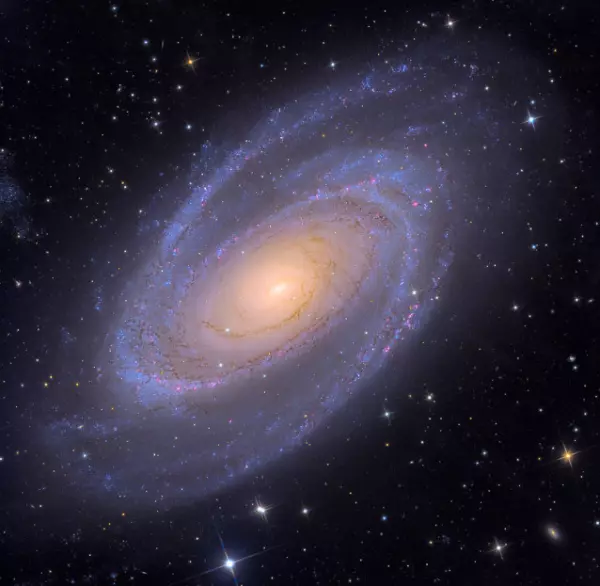
Bode’s Galaxy (Messier 81). Image: Adam Block/Mount Lemmon SkyCenter/University of Arizona
Messier 81 is tilted at an oblique angle when seen from Earth. Its spiral arms consist of young hot stars, bluish in colour, that were formed within the last few million years. The spiral arms also contain a stellar population formed about 600 million years ago.
The central bulge of M81 is home to significantly older stars, red in colour, and much larger than the central bulge of our own galaxy, the Milky Way.
Bode’s Galaxy was named after Johann Elert Bode, the German astronomer who discovered it on December 31, 1774, along with the nearby Cigar Galaxy (Messier 82). Pierre Méchain found both galaxies independently in August 1779 and reported the discovery to Charles Messier, who added them to the Messier catalogue as M81 and M82 on February 9, 1781.
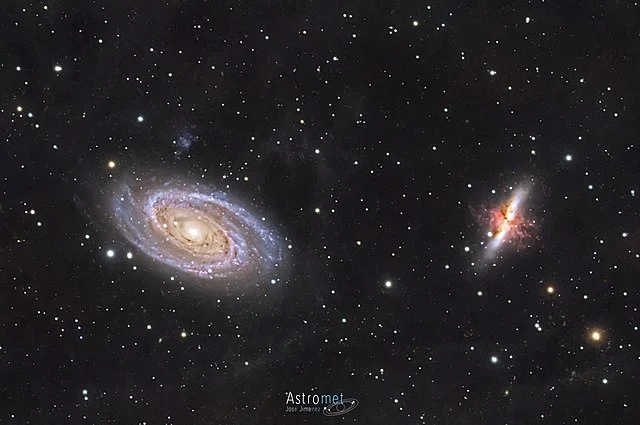
Bode’s Galaxy and the Cigar Galaxy (M81 and M82), image: José Jiménez (CC BY 2.0)
Bode’s Galaxy is the largest member of the M81 Group, a group of 34 galaxies lying in Ursa Major constellation. It has a strong gravitational effect on Messier 82 (Cigar Galaxy) and NGC 3077, two other prominent members of the group.
The close encounter between the galaxies occurred about 300 million years ago. As a result, all three galaxies have had hydrogen gas stripped away. The gravitational interaction has also resulted in the formation of filamentary structures in the group. The filaments are made of the gas that is being stripped away from the three galaxies. The interaction has also caused the gas to fall into the central regions of Messier 82 and NGC 3077, resulting in increased star-forming activity.
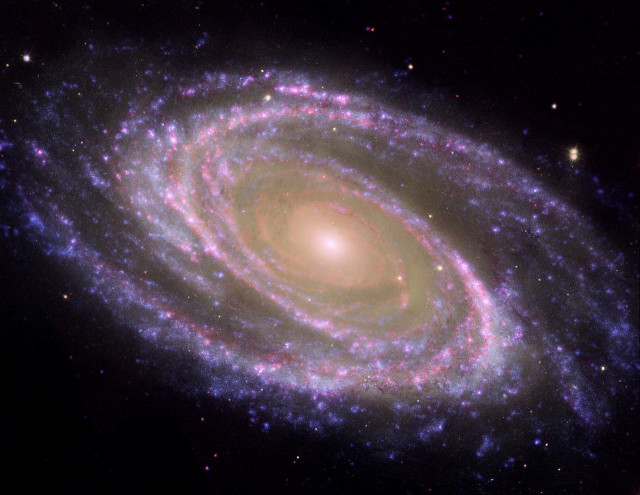
This beautiful galaxy is tilted at an oblique angle on to our line of sight, giving a “birds-eye view” of the spiral structure. The galaxy is similar to our Milky Way, but our favorable view provides a better picture of the typical architecture of spiral galaxies. M81 may be undergoing a surge of star formation along the spiral arms due to a close encounter it may have had with its nearby spiral galaxy NGC 3077 and a nearby starburst galaxy (M82) about 300 million years ago. M81 is one of the brightest galaxies that can be seen from the Earth. It is high in the northern sky in the circumpolar constellation Ursa Major, the Great Bear. At an apparent magnitude of 6.8 it is just at the limit of unaided-eye visibility. The galaxy’s angular size is about the same as that of the Full Moon. This image combines data from the Hubble Space Telescope, the Spitzer Space Telescope, and the Galaxy Evolution Explorer (GALEX) missions. The GALEX ultraviolet data were from the far-UV portion of the spectrum (135 to 175 nanometers). The Spitzer infrared data were taken with the IRAC 4 detector (8 microns). The Hubble data were taken at the blue portion of the spectrum. Image: Hubble data: NASA, ESA, and A. Zezas (Harvard-Smithsonian Center for Astrophysics); GALEX data: NASA, JPL-Caltech, GALEX Team, J. Huchra et al. (Harvard-Smithsonian Center for Astrophysics); Spitzer data: NASA/JPL/Caltech/S. Willner (Harvard-Smithsonian Center for Astrophysics.
Bode’s Galaxy’s infrared emissions mostly come from the interstellar dust found within its spiral arms. The dust is associated with starburst regions. The hot, young blue stars heat the dust, increasing the level of emissions in the infrared.
Messier 81 can be found about 10 degrees northwest of the bright star Dubhe, Alpha Ursae Majoris. Dubhe is the star that marks the northwest corner of the Big Dipper‘s bowl. Several other galaxies in the M81 Group are also located in the vicinity. The Cigar Galaxy is located 38 arc minutes north of Bode’s Galaxy.
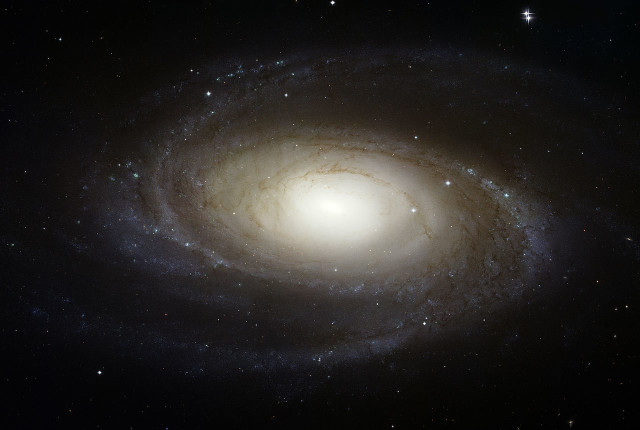
The spiral galaxy Messier 81 is tilted at an oblique angle on to our line of sight, giving a “birds-eye view” of the spiral structure. The galaxy is similar to our Milky Way, but our favorable view provides a better picture of the typical architecture of spiral galaxies. Though the galaxy is 11.6 million light-years away, NASA Hubble Space Telescope’s view is so sharp that it can resolve individual stars, along with open star clusters, globular star clusters, and even glowing regions of fluorescent gas. Image: NASA, ESA and the Hubble Heritage Team (STScI/AURA)
Bode’s Galaxy can easily be seen in binoculars and amateur telescopes, but is not visible to the unaided eye unless viewing conditions are exceptionally good. The structures within M81 can be seen in 8-inch or larger telescopes.
M81 and M82 are popular targets for both amateur and professional astronomers: M81 because it is an excellent example of a grand design spiral galaxy and M82 because it is a well-known and long studied starburst galaxy, with new stars being formed at exceptionally high rates.
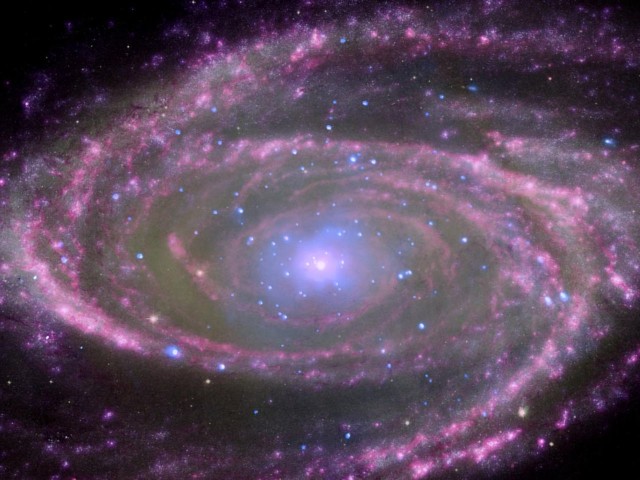
At the center of spiral galaxy M81 is a supermassive black hole about 70 million times more massive than our sun. A study using data from Chandra and ground-based telescopes, combined with detailed theoretical models, shows that the supermassive black hole in M81 feeds just like stellar mass black holes, with masses of only about ten times that of the sun. This discovery supports Einstein’s relativity theory that states black holes of all sizes have similar properties. Image: X-ray: NASA/CXC/Wisconsin/D.Pooley & CfA/A.Zezas; Optical: NASA/ESA/CfA/A.Zezas; UV: NASA/JPL-Caltech/CfA/J.Huchra et al.; IR: NASA/JPL-Caltech/CfA
A supernova was detected in Bode’s Galaxy on March 28, 1993. Designated SN 1993J, it was the second brightest supernova event seen in the 20th century at the time of discovery. It was classified as a Type IIb supernova. SN 1993J was the only supernova observed in Messier 81.
Facts
Bode’s Galaxy – Messier 81 (NGC 3031)
Constellation: Ursa Major
Coordinates: 09h 55m 33.2s (right ascension), +69°03’55” (declination)
Type: SA(s)ab
Distance 11.8 ± 0.4 million light years (3.62 ± 0.12 Mpc)
Apparent magnitude: 6.94
Apparent size: 26.9 × 14.1 arc minutes
Designations: Bode’s Galaxy, Messier 81, M81, NGC 3031, UGC 5318, PGC 28630
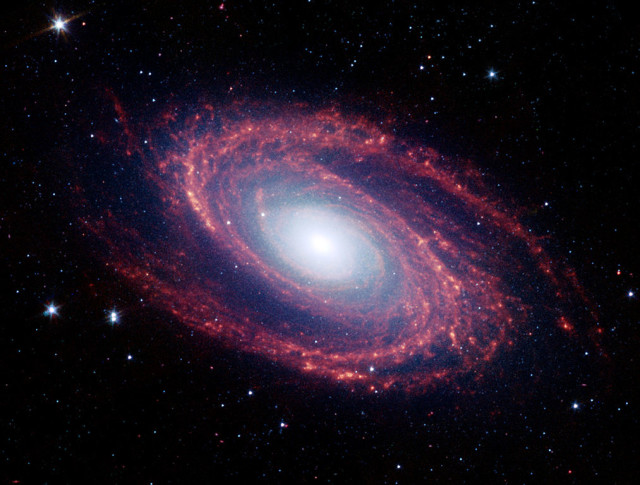
The spiral arms of the nearby galaxy Messier 81 are highlighted in this NASA Spitzer Space Telescope image. Located in the northern constellation of Ursa Major (which also includes the Big Dipper), this galaxy is easily visible through binoculars or a small telescope. M81 is located at a distance of 12 million light-years. Because of its proximity, M81 provides astronomers with an enticing opportunity to study the anatomy of a spiral galaxy in detail. The unprecedented spatial resolution and sensitivity of Spitzer at infrared wavelengths show a clear separation between the several key constituents of the galaxy: the old stars, the interstellar dust heated by star formation activity, and the embedded sites of massive star formation. The infrared images also permit quantitative measurements of the galaxy’s overall dust content, as well as the rate at which new stars are being formed. Image: NASA/JPL-Caltech/S. Willner (Harvard-Smithsonian Center for Astrophysics)